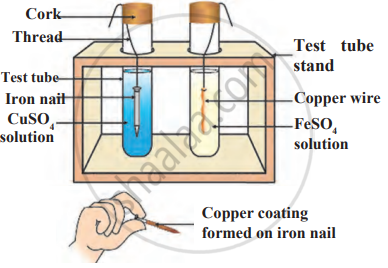Advertisements
Advertisements
प्रश्न
Write chemical equation for the event.
Iron filings are dropped in aqueous solution of copper sulphate.
Iron dissolved in aqueous solution of copper sulphate.
उत्तर
Iron displaces copper from copper sulphate solution forming ferrous sulphate and copper.
\[\ce{\underset{\text{Iron}}{Fe_{(s)}} + \underset{\text{Copper sulphate}}{CuSO_{4(aq)}} -> \underset{\text{Ferrous sulphate}}{FeSO_{4(aq)}} + \underset{\text{Copper}}{Cu_{(s)}}}\]
संबंधित प्रश्न
What do you observe when silver nitrate is added to a solution of sodium chloride?
How will you obtain Silver chloride from silver nitrate.
Also give balanced equations for the reactions
How will you obtain Zinc chloride from zinc.
Also give balanced equations for the reactions
What is meant by the metal reactivity series ? State its importance, (any two points).
Write the chemical equation for the event.
A reaction was brought about between ferric oxide and aluminum.
Write chemical equation for the event.
Electrolysis of alumina is done.
State what is meant by the ‘reactivity series of metals’
Give a balanced equation for the reversible catalytic reaction involving nitrogen as one of the reactants.
Select the correct answer for the statement given below:
The catalyst used in the catalytic reaction involving the reactants nitrogen and hydrogen.
Select the correct answer for the statement given below:
A neutral oxide which does not react with an acid or a base to give salt and water.
Classify the following metals based on their reactivity.
Cu, Zn, Ca, Mg, Fe, Na, Li, Hg
| More reactive | Moderately reactive | Less reactive |
Explain the following reaction with the balanced equation.
Sulphur burns in air
Observe the following diagram and identify the type of reaction and write observation.

Compound X and aluminium are used to join railway tracks.
- Identify the compound X
- Name the reaction
- Write down its reaction.
An element A reacts with water to form a compound B which is used in white washing. The compound B on heating forms an oxide C which on treatment with water gives back B. Identify A, B and C and give the reactions involved.
Give the steps involved in the extraction of metals of low and medium reactivity from their respective sulphide ores.
An element A burns with golden flame in air. It reacts with another element B, atomic number 17 to give a product C. An aqueous solution of product C on electrolysis gives a compound D and liberates hydrogen. Identify A, B, C and D. Also write down the equations for the reactions involved.
Metal ‘A’ has electronic configuration 2, 8, 1 and metal ‘B’ has electronic configuration 2, 8, 8, 2. Out of these, which metal is more reactive? Write the reaction of this metal with dilute HCl acid.
Three metal samples of magnesium, aluminium and iron were taken and rubbed with sandpaper. These samples were then put separately in test tubes containing dilute hydrochloric acid. Thermometers were also suspended in each test tube so that their bulbs dipped in the acid. The rate of formation of bubbles was observed. The above activity was repeated with dilute nitric acid and the observations were recorded.
Answer the following questions:
(i) When the activity was done with dilute hydrochloric acid, then in which one of the test tubes was the rate of formation of bubbles the fastest and the thermometer showed the highest temperature?
(ii) Which metal did not react with dilute hydrochloric acid? Give reason.
(iii) Why is hydrogen gas not evolved when a metal reacts with dilute nitric acid? Name the ultimate products formed in the reaction.
OR
Name the type of reaction on the basis of which the reactivity of metals is decided. You have two metals X and Y. How would you decide which is more reactive than the other?
